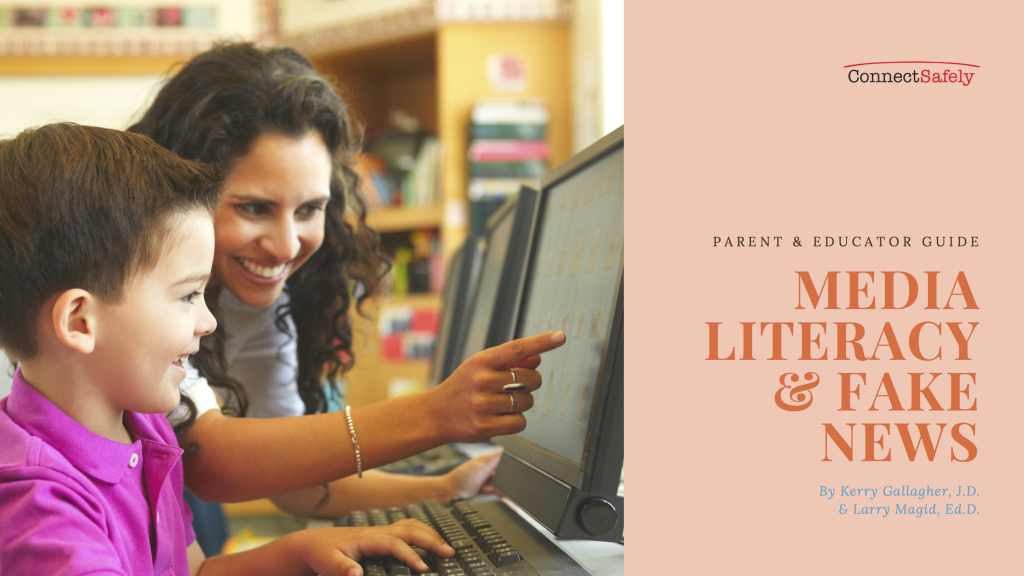

Long before the term “fake news” entered our vocabulary, I had been complaining about people spreading false information online. Now I’m doing something about it with a new free online booklet aimed at parents and educators.
The new publication goes after the root cause of fake news -– media literacy. The Parent and Educator Guide to Media Literacy and Fake News is a publication of ConnectSafely.org, the nonprofit internet safety organization I co-founded. My co-author, Kerry Gallagher, is a former public school history teacher, ConnectSafely’s part-time director of K-12 education and the digital learning specialist at St. John’s Prep in Danvers, Mass.
Those who deliberately create fake news often have a motive, whether it’s financial gain, the ability to influence the outcome of an election or anything else that may benefit them or causes they support. Others spread fake news for the same reason some people vandalize – just to make trouble or to see what they can get away with.
What we can do is help media consumers become more critical thinkers so they’re less likely to believe and spread fake news. A Stanford Graduate School of Education study recently found that more than 80 percent of middle and high school students surveyed were unable to distinguish between advertisements and real news stories. But don’t be smug if you’re a grownup. A recent Pew study found that nearly a quarter of adults admit to sharing fake news in the past. Most didn’t know it was fake when they shared it.
Sometimes fake news can be hard to distinguish from real news, but there are clues. In our “top 5 questions” portion of the guide, we urge people to consider the source and other stories coming from that source. Do they ring true? Is the URL legitimate? Does the “news story” seem one-sided or biased toward a particular point of view? Also, consider the article’s author. Is there evidence that it’s a real person? Search for the source and author to see what else they’ve published and what others are saying about them.
Sometimes you can tell if a story is true by copying a string of its text and pasting it into a search engine. Often (but not always) this will bring up sites that may dispute or confirm the story, but it may also bring up other fake news sites that repeat the story. FactCheck.org has other good tips for spotting fake news.
Of course, not all “fake” stories are malicious. I’m a big fan of good parody sites like the Onion and the way Saturday Night Live, Comedy Central’s Daily Show and some late-night shows take creative license with real news for comedic effect or political satire. All I ask is that people learn to recognize fact from fiction and not share fiction as if it were fact.
And, speaking of sharing, I think it’s important for everyone on social media to realize that they have a responsibility to tell the truth, even if they’re not professional journalists. My friend and former Mercury News columnist Dan Gillmor popularized the term “citizen journalist,” which pretty much describes nearly everyone on social media today. It’s fine to use social media to express your opinions, but that doesn’t relieve you from the responsibility to tell the truth. When you see something on social media that seems a bit fishy, don’t share it – putting your reputation on the line — until you check it out.
It’s also important to teach young people how to spot the difference between fact and opinion. I have no problem with columnists and commentators expressing their opinion. I do that all the time. But readers need to be able to spot the difference between a news story and an opinion piece. But even opinion pieces should be based on facts and any speculation or conjecture should be clearly labeled as such.
Media literacy also requires emotional literacy. Emotion plays an enormous role in persuasion in both commercial advertising and political messaging. Commercial ads often sell a lifestyle along with their products and it’s increasingly common for political messaging to play on people’s emotions, including their hopes and fears. For that reason, we partnered with the Yale Center for Emotional Intelligence in preparing the guide, including an expert tip from associate director Robin Stern, who recommends that adults “check in with your own feelings first and keep calm when talking to your children – even about a ‘charged’ piece of news.” She suggests that adults encourage children to “think about how producers create media to provoke feelings in the audience,” and to “share your own thoughts and feelings.”
Finally, we urge parents and educators to teach kids to distinguish between healthy skepticism and unhealthy cynicism. It’s good to question media, regardless of how well established it may be, but it’s also essential to learn how to glean truth and insight from the media around us so that, together, we can develop a better understanding of our world and how to make it better.